Sorrento guide
Eating and drinking
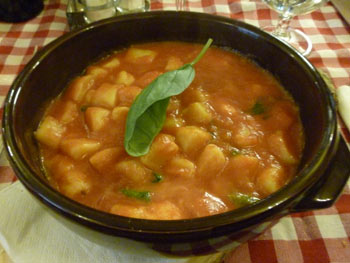
Sorrento’s traditional appeal rests partly upon food and drink. The plain and the slopes behind it were once covered in orange and lemon groves, and around Sorrento there are many of these left. If you go walking in the area you’ll see abundant citrus cultivation as well as terraces of olive trees. Among the trees you’ll also often see vegetables being cultivated, including artichokes, courgettes and tomatoes. Traditionally every scrap of fertile land has been used, and despite the growth of tourism, small-scale agriculture is still a way of life on the Sorrentine peninsula. Local produce from this and neighbouring areas also includes fresh seafood and the cheeses which are a Campania speciality including buffalo mozzarella.
Sorrento’s own speciality dish is gnocchi alla sorrentina, potato gnocchi with tomato, mozzarella and basil. Local wines from the Naples area, including Lacryma Christi from the slopes of Vesuvius, are on most wine lists, and the peninsula produces its own liqueurs from natural ingredients including fennel, nuts and lemons (the famous limoncello). Freshly-squeezed orange juice (una spremuta di arancia) is a great non-alcoholic option for a cooling drink. The desserts of the Naples area are renowned throughout Italy.
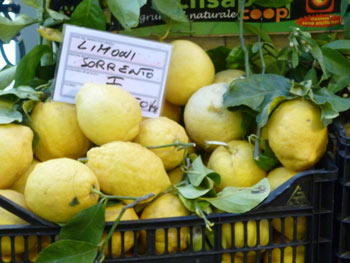
Sorrento’s restaurants and cafes are aimed principally at tourists. Most are Italian and reasonably traditional, but with some concessions to mainstream British tastes. Evening meals start early, bread rolls are brought with butter, menus are in English and you will see menu choices that will raise an eyebrow with the Italy purist, including hot dogs and burgers. That doesn’t mean you can’t eat well, though. The town has Italian residents and visitors too, and their exacting standards, combined with the amount of competition among eateries in Sorrento, ensures that you can find good food – and at fair prices, too. Even in the best restaurants, it’s pretty hard to avoid a touristy atmosphere – but this is a major resort, after all
There are still a few working fishing boats in the area, and the best place to enjoy freshly-caught seafood is down at Marina Grande, Sorrento’s fishing hamlet. Several unpretentious restaurants are situated right at the water’s edge, and a couple are run by fishermen. At ‘O Puledrone you can even book a fishing trip and go out with the fishermen in their small boat before enjoying the ‘catch’ as part of your meal.
Up in the main part of Sorrento, good places to eat include ‘O Parucchiano La Favorita (Corso Italia 71/73), a remarkable historic restaurant which behind an ordinary doorway conceals several large garden terraces, both indoors and out. It’s a workmanlike place but worth visiting for the surroundings. At Re Food (Via Giuliani 30, Via dell’Accademia 10) diners will find a good choice of dishes, and pizzas too, at reasonable prices. You can see the pizzaiolo (pizza chef) at work. ‘O Murzill (Via dell’Accademia 17) has a tiny interior, red check tablecloths, a friendly welcome and dishes such as risotto with squid and pumpkin.
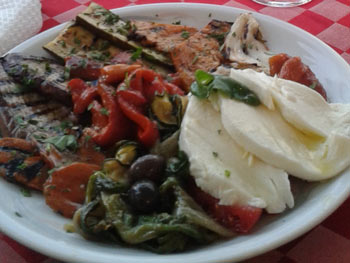
My two best meals in Sorrento were at opposite extremes. For a bargain lunch with local workers as well as tourists, try Chantecler’s Trattoria (Via Pieta 38, close to the Cathedral), where you can eat simple pasta dishes with a glass of wine for just a few euros. For fine food and a formal atmosphere, Ristorante Museo Caruso offers imaginative takes on traditional Italian food, some nice little extras for a memorable meal and an atmospheric interior lined with photographs and memorabilia of Enrico Caruso – whose recordings of course provide the soundtrack, when a local guitarist isn’t serenading the tables.
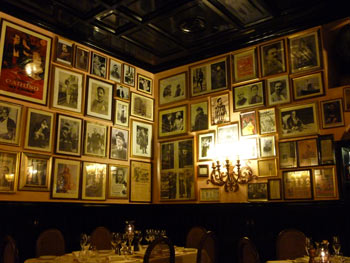
Bars and cafés are dotted among the restaurants in the tourist lanes of Sorrento. On Piazza Tasso are several bars with outdoor tables for a drink and people-watching. The Fauno Bar, on the southern side of the square, is a classic destination; touristy and not cheap, but still probably the definitive place to sit and watch the world go by. The most glamorous and panoramic bars in Sorrento are on the terraces and rooftops of the town’s elegant cliff-top hotels – expect wonderful surroundings but high prices. Along at Sant’Agnello, a 20-minute walk or bus-ride away, Bar La Terrazza in Piazzetta Marinella is a bar with tables on a headland with lovely views back along the coast to Sorrento, and over the bay to Vesuvius. A romantic spot for an early-evening aperitivo.
Sorrento’s best-known gelateria is Gelateria Primavera, on Corso Italia between Piazza Tasso and the Duomo. Mobbed at busy times, the photo-lined ice cream bar offers a wide range of gelato flavours; a bit pricier than the Italian average. The whole Naples area is famed not just for pizza but for sweet desserts. These include sfogliatelle pastries, babà with rum or limoncello, and the delicious delizia al limone. You can buy these at a bar or pasticceria to eat on the spot or to take away for an indulgent picnic or self-catered dessert.
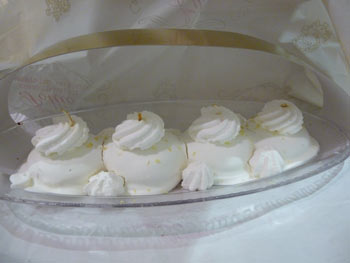
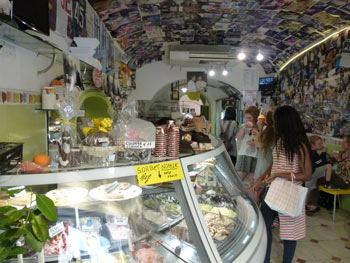
Shopping
The edible and drinkable produce of the local area is a big feature of Sorrento shops. Limoncello is probably the most clichéd of holiday souvenirs (joked about as “that bottle” that sits undrunk in the cupboard for years), but tourists can still have fun trying free tastings and watching the drink being produced. Just outside the centre, not far from the railway station, I Giardini di Cataldo (Via Correale, 27) gives tours and talks at their limoncello workshop set in a lemon grove. More locally-produced foodstuffs can be sampled and bought at the Fattoria Terranova shop in Piazza Tasso, which sells products from the family’s organic farm, where you can also book cookery classes. Don’t miss the historic majolica-tiled courtyard alongside.
Sorrento’s main tourist shopping lane, Via San Cesareo, starts in Piazza Tasso. Along this crowded little street you can buy all kinds of lemon-related souvenirs; everything lemon from lemons themselves to lemon soaps, lemon perfumes, lemon chocolates, lemon pasta, lemon biscuits, lemon-decorated ceramics, lemon-print aprons. At a couple of the larger stores you can see the limoncello being produced. One of the best shops is Limonoro, where you can taste and buy good-quality limoncello-filled chocolate dragées and biscuits. Other shops along the lane sell ice cream, fruit and vegetables, coral jewellery, clothes and other speciality foods.
As you move further away from Piazza Tasso along Via San Cesareo and its continuation, Via Fuoro, you find more interesting craft boutiques, intarsia and ceramic workshops and salerooms, sandals made to measure in a few minutes, linen holiday garments, Italian foods and spices, interspersed with a couple of shrines, bars and restaurants. Since the 19th century Sorrento has been a centre for the craft of intarsia, marquetry, originally imported as a skill from Nice. Inlaid wood items from pretty boxes to decorative tables can be found in artisan workshops and souvenir stores around town, from a big showroom on Piazza Tasso (Gargiulo & Januzzi) to small family workshops like Augusto & Luca (Via Fuoro 50/c) and there is a museum dedicated to the art, the Museo Bottega della Tarsia Lignea. Among the appealing artisan workshops is Terrerosse (Via Fuoro 73), selling individual handicrafts inspired by the local landscape and myths, which are a long way from the mass-produced souvenirs sold along the same street; highlights include ceramics with fish designs, including tiny affordable bowls which would fit easily in luggage.
If you’re looking for a guidebook, memento or novel to read, Libreria Tasso (Via San Cesareo 96) has an excellent selection of books including volumes of historic photographs of Sorrento – pricey but tempting – and English-language novels. The bookshop has a wide choice of books in English including many with an Italian/local theme: a literary guide, Siren Land by Norman Douglas and more. There’s another branch in Piazza Lauro, near the station.
High-street shops can be found along Corso Italia, the main street running through Piazza Tasso. Here you’ll find high-end fashion as well as cheaper brands of clothes and accessories. At times semi-pedestrianised, this street is one of the busy destinations for the Italians’ evening stroll, the passeggiata. Along with leisurely meals and evening drinks, browsing the town’s boutiques and window-shopping are very much a part of the Sorrento experience, best enjoyed in the shade of the centre’s historic buildings after the hottest part of the day is over.
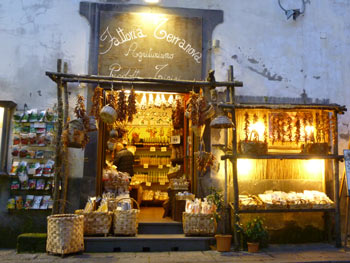
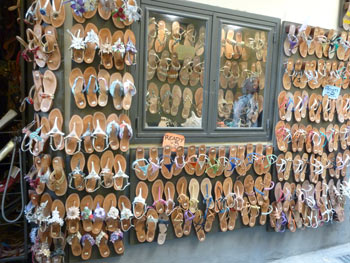
On this site
Useful links
Sorrento hotels, B&Bs & apartments